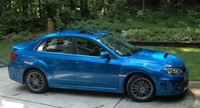2011 Subaru Impreza WRX Road Test and Review
MORE: Subaru Specs, Comparisons, Prices and Reviews - Subaru Buyers Guide
2011 SUBARU WRX
A Rally Racer for You and I
By Steve Purdy
TheAutoChannel.com
Detroit Bureau
Subaru won the World Rally Manufacturers Championship three years running in 1995, ’96 and ’97. They haven’t won it since (though they’ve had some driver’s championships to boast about) and dropped out of that hunt at the end of the 2008 season. Contesting one the wildest, most demanding motor sports series on the planet helped put Subaru on the map and gave unquestioned legitimacy to the tough, innovative drive system they call Symmetrical All-Wheel Drive.
 |
 |
So the little screamer we’re testing this week, the Impreza WRX, represents the spirit of the World Rally Championship. It just makes sense to put lots of power into the lightest car possible while concentrating on getting that power to the road under maximum control if you are to contest this kind of racing – that is, on gravel, snow, ice, ruts, sand, and whatever other challenging surfaces you can find.
 |
On the road it feels like a racecar, once it gets going. We must keep the rpms up - way up – to maximize performance, though. Below 3,000 rpm we feel it struggling and wheezing. The turbo is remarkably slow to spool up but once up provides wonderful thrust. Then right up to red line it feels like it wants to go air born.
I had no race track or gravel road time with the WRX this week, but I found the handling to be crisp and balanced without being too harsh or jumpy. Steering feel and feedback were adequate. Pushing aggressively through paved corners and the few twisties we have around here caused not a hint of consternation. I could have pushed twice as hard with full confidence. I expect the increase in the car’s width has some effect. Were we to go rally racing with it, or even autocrossing, we might want to stiffen the suspension a bit more. As it is, it won’t beat us up in normal driving.
 |
 |
Trunk space is not bad for such a small car with 11.3 cubic-feet available for our stuff. The 5-door hatchback offers 19 cubic-feet before folding the rear seats. With rear seat backs folded we get up to 44.4 cubic-feet of space.
The WRX starts at $25,495 for the entry level with base price rising to $28,995 for the Limited. If you prefer the hotter STI versions of either expect to spend another 8 grand or so. That seems like a huge premium for another 40 horsepower but you’ll get some other stuff as well, like suspension tweaks, a close-ration 6-speed manual transmission, Brembo brakes, 18-inch wheels, HID headlights, special STI steering wheel, special gauge package and leather interior.
Subaru Safety - Subaru is the only manufacturer with IIHS Top Safety Picks for all models, two years in a row. They say that they don't shy away from crash tests, because safety is at the forefront of Subaru design.
Subaru’s full warranty covers the whole car for 3 years or 36,000 miles and the powertrain for 5 years or 60,000 miles.
For the price you can get bigger cars, fancier cars and cars with more content. But for the price (base WRX, that is) you’ll not find one with much more rip-snortin’ all-terrain, toss-it-around fun than this little rally racer.
© Steve Purdy, Shunpiker Productions, All Rights Reserved



